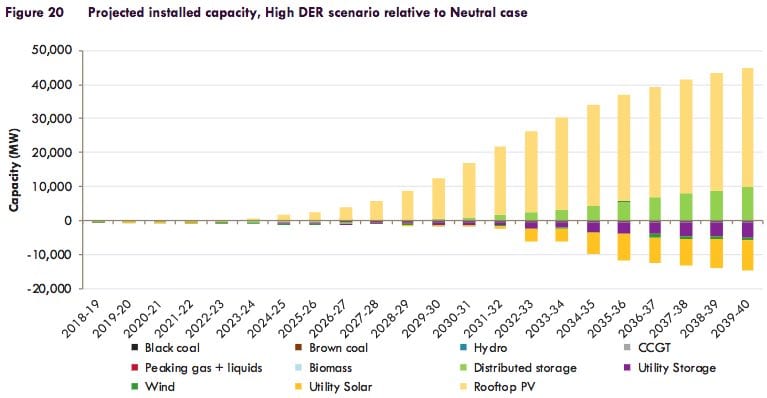The amount of electricity from rooftop solar on Australian homes and businesses could reach 50,000 GWh by 2040, meaning it would account for 22 per cent of national demand and overtake the combined output of black and brown coal at that time.
The Australian Energy Market Operator’s Integrated System Plan that was published on Tuesday put distributed solar, which with battery storage is a key component of DER (or distributed energy), on track to supply more power to the national grid than coal within little more than 20 years.
According to the ISP, in 2040 rooftop PV generation is projected to reach approximately 31TWh across the NEM in its Neutral (below), Slow change, and Fast change scenarios, and nearly 50TWh in the high DER scenario.
This represents between 13 and 22 per cent of forecast total underlying NEM electricity consumption, the report says, and has the potential to “deliver a major cost saving to consumers.” At the top end, that will be equivalent or exceed the output of brown and black coal by 2040. (See graph above).
And it will reduce costs n a number of ways, AEMO explains. For one, it would reduce the need for utility-scale renewable generation, thus cutting the costs associated with connecting these assets within the transmission system.
Efficiency gains associated with lowering overall system losses are also anticipated, the report says, as energy is generated at the point of consumption.
And perhaps most importantly, there is the impact that distributed solar and storage has on reducing local peak loads, providing network savings at both the transmission and distribution level, that can then be passed on to consumers. This will be as much as $4 billion in savings.
These savings would be greatest, of course, under the ISP’s High DER scenario, which considers a future where distributed rooftop PV generation, battery storage, and other demand-based resources
at the consumer level are higher than in the Neutral case.
Indeed, AEMO says that the purpose of modelling the High DER scenario was to examine how increased distributed solar and storage could impact on – ie. reduce – investment needs for utility-scale generation and storage and transmission. (See chart above.)
(This is an excerpt from a story from our sister publication One Step Off The Grid. To read more, please click on original here).











